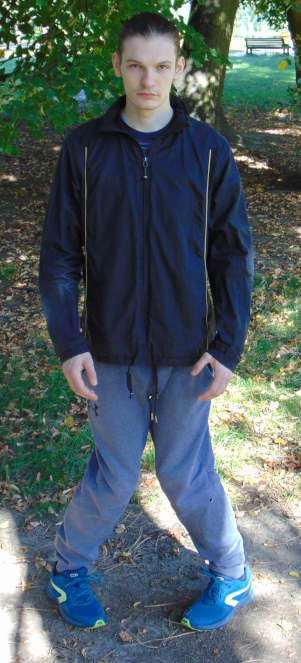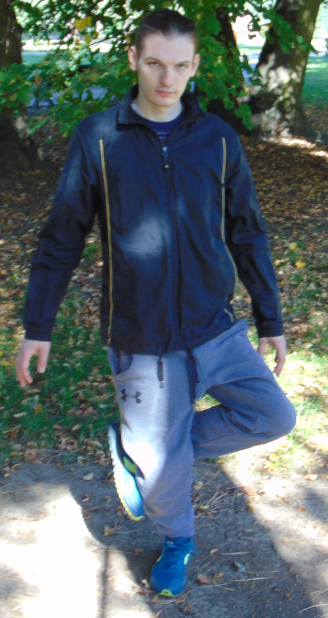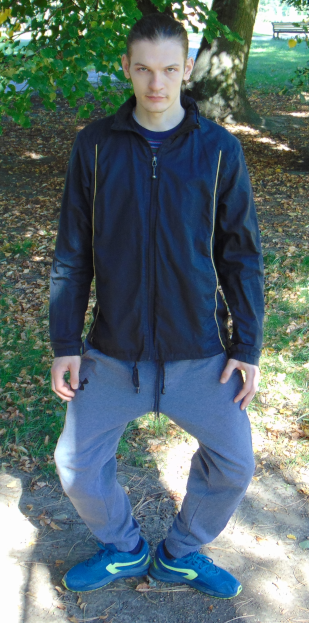The tactical scheme of Batuque
03/2020 - a slight update
We will analyse the tactics of Batuque, as described in Frede Abreu's book "Batuque, luta braba"; but using our knowledge of body mechanics.
This is 'the' article on Batuque; it completely explains the principle of the game and the techniques used.
Introduction
The key to understanding Batuque is that the principle of the game is using positional nerve disruptors to defend against opponent's takedowns.
Positional nerve disruptor is a position that by itself neutralizes certain bandas: The moment the opponent applied a banda, if you stood correctly, he disrupted his own nerves and his takedown failed.
Just the way you stand can nerve disrupt his banda - this is the core of Batuque.
(For introduction to positional nerve disruptors, read my article on Clube X).
This is interesting, because from a 'rough game', Batuque becomes a clever game of using positional nerve disruptors.
Basics
The following two nerve disruptor positions were used:
1)Clube X
:
(also known as leque; don't confuse it with Leque, hand technique from Bahian Capoeira)
(this is the same disruptor position as was used in Carioca to disrupt the grabs and sweeps)
- neutralizes (nerve disrupts) frontal raspa, rasteira, dourado, rapa, corta capim, amarrada, internal tracada, black banda, tranco, Eagle lifting banda
2)Figure 4

(also known as Letra)
- neutralizes rear raspa, bau, jogada, dourada, banda de frente, banda de lado, banda de costas, cruzada, Rooster thigh bump (traçadas, me esquece, cruz), encruzilhada(unless it is done with quasiNegaça), Eagle lifting banda
- when doing Figure 4 in combat context, squeeze your thighs together to protect the groin; but without changing the archetype!
Notes:
- both positions neutralize Eagle lifting banda; this will be important later on.
- there existed a third position, with heels together and knees bend; legs forming an O (Figure O). Technically, it works the same as Clube X.

- all three positions use Bear archetype.
The game itself
In each Batuque game, there is the attacker - the one that applies bandas; and the defender - the one that stands still and defends the bandas.
The attacker tricks around the defender and applies a banda (see below)
If the attacker manages to take the defender down, he wins; otherwise, he loses (and they can switch sides).
The game has three phases:
First phase
In the first phase, the defender stands 'planted' in one of the above disruptor positions (Clube X or Figure 4). The attacker must pick and apply a banda that is not neutralized by that particular position(see above).
The defender either falls down, which is end of the game; or he remains standing, more or less off ballance.
Second phase
After getting swept with the banda, the defender is unbalanced, in 'banda solta' (one leg lifted) position. This is important; because it is neither one of the nerve disruptor positions; allowing the Eagle lifting banda.
The attacker takes advantage of this and applies an Eagle lifting banda (Frede Abreu calls this 'bau'; but this is not Bau in the sense we use it, ie belly bump with Dom Rooster+LightLegs mechanics; instead, it is applied by hugging opponent's waist with one hand, which uses Eagle mechanics).
Why Eagle lifting banda? Because out of the Batuque bandas, this one is the most secure; and impossible to defend unless the opponent uses one of the disruptor positions. It also is especially effective against 'banda solta', a position with one leg lifted.
So while the attacker attacks with Lifting banda, the defender desperately tries to return to one of the disruptor positions to neutralize it; even while being lifted.
If he doesn't succeed, he gets thrown with a Lifting banda. If he succeeds, this disrupts the Lifting banda and the attacker must put him back on the ground.
Third phase
Here, attacker has one last chance to apply a banda, after the defender assumed one of the disruptor stances. He again must pick the proper one, as in step one.
The defender either gets taken down this time; or remains standing.
This is the end of the game
Implications
Note the implications of the above:
-In the first phase, if the defender doesn't know the nerve disruptor positions, he gets thrown with an Eagle lifting banda right away.
-In the first phase, if the attacker picks a wrong banda, he gets nerve disrupted right away and cannot proceed to phase 2.
-In the second phase, if the attacker tries to use a normal banda when the defender is in banda solta, it is easy for the defender to simply step down with the lifted leg and neutralize it.
-In the first or third phase, if the attacker tries Eagle lifting banda right away, it is easy to disrupt it with either of the disruptor positions.
It is the above that gives the game of Batuque its tactical scheme.
It is built upon the constant interplay between Eagle lifting banda, the two disruptor positions, banda solta position and the other bandas. (Somewhat like the game of rock-paper-scissors)
The Batuque footwork & Powerswiping
In the first phase, the attacker uses a special tricking footwork to hide his intention(ie. the banda he is going to apply):
This footwork uses Monkey+Seduction1 archetype; which is the same mechanics as (the real) Bahian ginga. However, you do not do full steps as in ginga; instead, you just kind of rock and stamp in place.
(You can see this in the old video of Batuque: https://www.youtube.com/watch?v=sj8ecwOLc50 )
This footwork allows you to hide your approach and to apply the banda suddenly.
The defender stands still.
-
But aside from this external purpose, the Batuque footwork has one internal, neural use.
When you stamp on the ground repeatedly using Monkey+Seduction1, energy gradually accumulates in your lower body. Using this energy, you can then throw an extremely powerful banda, much more sudden and powerful than the bandas done from standing still, without this energy (mechanically, this is done by temporarily switching lower body to Dom Eagle mechanics). I call this method of throwing bandas Powerswiping.
This is probably how the real Batuqueiros had done their bandas. (Unfortunatelly, Powerswiping cannot be used in Capoeiragem, as it needs the stamping to accumulate the energy; it does not work from ginga).
This again shows that even the 'simple, rough game' of Batuque used very deep mechanical principles under the surface.
Done properly, Powerswiping makes the bandas lightning-quick and powerful; for example, Encruzilhada is a lot faster etc.
Note: By the design of the game scheme, Powerswiping can only be used in the first phase of the game, because only there you use Batuque footwork; in the next two phases, bandas have to be done normally.
General notes
1) There are takedowns that are not neutralized by either of the positional disruptors; these can be used freely (but usually pay for it by the complexity and are easy to evade):
-Thesoura
-Encruzilhada (if done with the quasiNegaça)
-Rabo de arraia
To escape Thesoura, equip LightLegs and jump up with both legs as the opponent applies the legs clasping; then spread your legs to the sides (above his legs) and land. This is described by Burlamaqui (1928)
To escape Encruzilhada, equip LightLegs and as the opponent tries to twist you down from your left side, jump out of the grasp, turning to the left; landing on your hands (behind your back) and your bent right leg; extending the left leg forward. This is also described by Burlamaqui.
To escape Rabo de arraia, equip LightLegs and as the opponent tries to bump your left leg from your left with his buttocks, jump to the right with both legs and turn leftward; landing on your hands and sprawling your legs behind you. (This one was derived by me; from the escapes from Thesoura and Encruzilhada).
Burlamaqui's Thesoura cannot be done from the Batuque footwork; you have to use the classic one.
2) Calcadeira,Calço and Boca de calça are neutralized by both disruptor positions;and cannot be used reliably against Banda solta; so they are not used in Batuque.
The same probably applies to Crawling tesoura and Black banda; which were probably more technique of old Bahian capoeira.
3) It is easy to step down from the Figure 4 position when the opponent attacks with, say, a Rasteira.
4) Notes to the book 'Batuque, luta braba':
- "amarrado" is probably our Internal traçada
- "banda amarrada" is our Banda amarrada. It is said to 'knock the opponent far out of roda'; here is why: Amarrada is neutralized by the Clube X; so it is used when the opponent stands in Figure 4. But the nerve strangle of Amarrada, when used against Figure 4 position, results in a big throw of the opponent.
- "batidas" are probably wrongly understood; the first two - "Bate-coxa"(thigh-bump) and "Bate-bariga"(belly-bump) are used to attack the Clube X position; while others must be used to "Bater o firme" or "Bater de letra" - attack the Figure 4 position.
5) In second phase("banda solta"), if opponent's leg is lifted to the rear (which can result for example from Dourada), Lifting banda cannot be applied. I believe that instead, you should apply Double leg banda: Seize opponent's legs with your arms around his knees (similar to Arrastao) and then tilt him sideways, dumping him on his head. I believe this technique was also used in old Batuque.
6) To escape Cruz, you can use the Smilodon balao; see Boca de calça and Banda de lado for description
Teaching Batuque
The basic version of Batuque can be taught as follows:
1)Teach:
- Frontal raspa
- Rear raspa
- Eagle lifting banda
2)Teach the two disruptor positions: Clube X and Figure 4.
Then show how Clube X neutralizes Frontal raspa; how Figure 4 neutralizes Rear raspa; and both neutralize Eagle lifting banda.
3)Demonstrate the tactical scheme:
- let the defender get into one of the disruptor positions; and apply appropriate raspa.
- if he remains standing, but in Banda solta, use Eagle lifting banda; he tries to get back to one of the disruptor positions
- if he manages to get it, finish with an appropriate raspa
-simple combo: right frontal Raspa, hop on the standing leg into right Lifting banda (later: if he disrupts it, spin into Encruzilhada)
-simple combo: left rear Raspa, step into right Lifting banda
4)Add other bandas
The magic of Batuque
To sum it up, in Batuque, there are three 'magic' skills:
-Powerswiping
-Nerve disruptor positions
-using LightLegs in Lifting banda (and some other bandas too)
This Web Page was Built with PageBreeze Free HTML Editor


